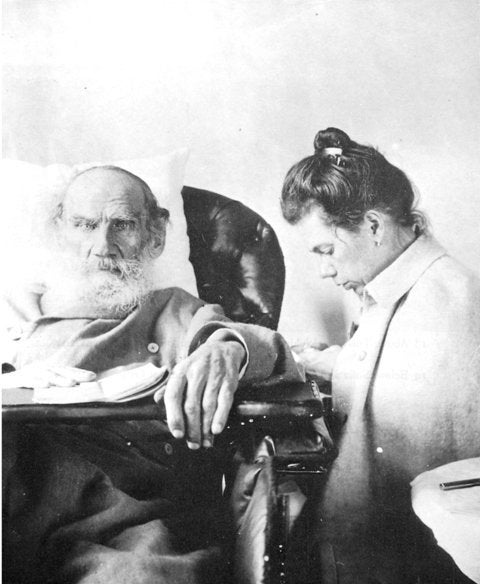
Reading War and Peace is like looking in a mirror and seeing myself with all of humanity beside me, reflected back. But it is not our surface appearances that are reflected: it is our internal struggles with how to live and why. All great novels reflect our strivings, inept and agile, for understanding life, and that is why we read them: to gain understanding and become more agile and less inept in our own lives. Of course we also read for pleasure and escape and comfort and thrills - but when explorations of understanding existence are combined with pleasure, escape, comfort, and thrills, then a truly great novel is made. And War and Peace is such a novel. Every type of person is represented (I saw people I know in every scene), every take on life is explored, and every possible relationship is examined. And through his great novel, Tolstoy advises that life can be re-started, from any age, at any stage.
Just as War and Peace itself can be started -- and re-started -- at any age, any stage. If you have been holding off from reading War and Peace because of its bulk or its war scenes or its huge population of characters, wait no longer. Although I have just finished reading the novel, it is time for to start reading it all over again. I cannot let go of the tide of ideas, the swirl of conversations and internal monologues obsessing over the meaning of existence, the purpose of life, and the elements of the human condition. Every character thinks about the whys and wherefores of his or her placement on this earth and we -- lucky us! -- are privy to those thoughts. Even better, we see how actions resulting from such deep-thinking often contradict the thoughts: how to act as we think? We strive, as Tolstoy's characters strive, for coherence and cohesion between our thoughts and our actions but life rarely plays out that way. Happiness, sorrow, pleasure, comfort, duty, greed, birth and death, war and peace: all these emotions and events are explored by Tolstoy's characters and illustrated by scenes of compassion and love and sacrifice, as much as by scenes of anger and stupidity and impulse.
I didn't need to read War and Peace to know that we human beings are deeply flawed, that we are bundles of conflicting needs and emotions and rules and beliefs. But Tolstoy shows me through his scenes of a battlefield or a party or at home, that humans are not defined or limited by our flaws; instead our flaws lead to failures and our failures change us. And so our flaws lead to change. And through change, we survive. I needed War and Peace to see the possibility offered by failing, and the potential for re-starting, when all seems lost.
Tolstoy also shows me that sudden or sustained moments of beauty and wonder also transform us, making our imperfections less important and our yearnings more important, and again offering the opportunity to restart a life that seems stalled or stagnant. There is a marvelous scene in War and Peace where Prince Andrey is journeying through a forest to visit the Rostov family. Andrey has entered a phase of his life where he wants to remain contained and unchanged within his own little world, and when he sees an old oak tree, "with branches broken off it ages ago and its old, cracked bark all scarred and broken", he finds communion with the tree: "He's right, that tree, a thousand times right...he and I know what life is. Our lives are over and done with!"
Later, when Andrey is traveling back through the forest after having fallen in love with Natasha, he finds the oak tree again. No longer barren and withered, the oak tree is resplendent with life and possibility, "spreading out in a canopy of lush, dark foliage and stirring gently as it wallowed in the evening sunshine." Andrey again finds the tree expresses his own state: "No, life isn't over... My life must be lived ..." Despite its lovely and rich leafing, the tree retains its form of trunk and branches; it has not changed beyond recognition, it is not a new tree. It is the same tree, transformed. Just as Andrey is the same man he was before, but he has been changed through his meeting with Natasha. He has been re-started.
Tolstoy tells me that life reels with change, bloats with failure, explodes with beauty - and never stops offering possibility. And I hear him.
How to live? I look for answers in books. War and Peace is a source to be mined again and again, a book that will never grow dusty for the re-start it offers, and for the enjoyment such re-starting can bring.
